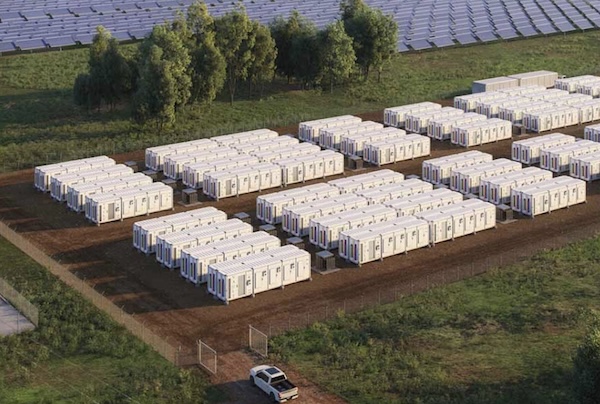Energy Storage
Craig Tropea
Solar
Jonathan Lwowski
Solar
Steve Macshane, CESSWI

Fine Airport Parking, a leader in premium off-airport parking services, announced that it has selected Zevtron, a cutting-edge electric vehicle (EV) charging technology provider, to deliver scalable and infrastructure-friendly EV charging at its two facilities serving George Bush Intercontinental Airport (IAH) in Houston.
As part of the initial deployment, Zevtron will install 16 chargers supporting 32 EV charging ports across both garages. Each charger will be powered by Zevtron’s white- labeled operating system, which provides Fine Airport Parking total control over who can use chargers and how they can be used, while also allowing the company to monetize EV charging. Zevtron’s platform is hardware agnostic, so it can be implemented to manage existing chargers at Fine Airport Parking locations, as well as the Zevtron chargers being deployed now at George Bush International Airport. Because it’s white labeled, the platform will allow Fine Airport Parking to expand their brand into EV Charging.
“Zevtron’s platform is by far the most innovative, user-friendly, and cost-effective EV charging solution we’ve come across,” said John Davey, Senior VP of Marketing and Strategy for Fine Airport Parking. “Because it’s fully customizable, it will give us complete control over how we manage and monetize our EV assets.”
Zevtron is implementing an innovative low-power charging system that allows multiple vehicles to be charged from a single 40-amp electrical feed, delivering multiple-port functionality per device. This approach enables Fine Airport Parking to leverage its existing electrical infrastructure with no additional utility or infrastructure upgrades—making the transition to EV support fast, efficient, and cost-effective. This creative approach enables parking owners and institutions to “right size” their operations, providing a customized charging approach that meets the owner’s unique needs while supporting the rapid growth of electric vehicle adoption. And it makes EV charging technology much more affordable and accessible to smaller operations and owners who have experienced sticker shock in the past from the prices of legacy EV charging technology providers.
“The Zevtron platform also has the scalability we need so the system will grow with us,” said Davey. “Being able to include EV charging with our reservation platform or implement pricing strategies will be extremely beneficial to us, as well as to our customers. Zevtron is giving us a turnkey solution that will allow us to easily recoup our investment because of the level customization they offer.”
Zevtron’s dual-port, low-power approach represents a breakthrough in EV infrastructure that emphasizes smarter and more efficient use of existing resources. This slow-charge approach is also perfect for airports because travelers typically park for several days at a time.
“Fine Airport Parking is one of America’s leading independent parking owner/operators, and we’re proud to support their EV infrastructure strategy,” said Bob Andrews, Zevtron’s founder. “Our platform is designed to offer seamless scalability, smart energy management, and powerful customization tools—making it ideal for owners and operators looking to deliver premium EV charging without breaking the grid or the budget.”
Following the successful deployment at IAH, Fine Airport Parking plans to roll out Zevtron EV charging solutions at its Hobby Airport location in Houston, followed by facilities serving Denver International Airport and Tulsa International Airport.
Fine Airport Parking | https://fineairportparking.com
Zevtron | https://zevtron.com/

FlexGen Power Systems LLC (“FlexGen”), a leading battery energy storage solution and energy management software provider, and Rosendin, the nation’s largest employee-owned electrical contracting company, are integrating their proprietary technology and solutions to leverage utility-scale Battery Energy Storage Systems (BESS) to support modern data centers without the need for traditional uninterruptible power supply (UPS) infrastructure.
The project will integrate proprietary technology and innovations from both Rosendin and FlexGen, including Rosendin’s BESSUPS design and method patent, and FlexGen’s Soft Grid Interconnection and Island Grid Transient Frequency Stabilization patents. The project will further leverage FlexGen's Innovation Lab to integrate its powerful HybridOS energy management system. This is complimented by Rosendin’s industry leading data center delivery experience and extensive mission critical and storage energy thought leadership.
The BESSUPS system offers several advantages, namely CEBMA-quality power on an uninterrupted basis on a massive scale while avoiding the use of generators for clients choosing to decarbonize. This approach offers further benefit to the end user of dispatchable power to the Utility upon demand. This approach also allows the end user to meet the evolving power dispatch and consumption dynamic with proven Utility-scale and -grade systems.
The energy demands of AI training workloads, high-density computing, and fast-shifting loads are stretching the limits of conventional power infrastructure inside data center buildings. FlexGen and Rosendin have been working on a utility-scale battery solution outside the data center building that would be a part of the medium-voltage (1000V to 35000V) infrastructure. The companies will bring to market a first-of-its-kind BESS system that can act as a reliable, high-performance alternative to conventional UPS systems outside the data center building while simplifying system architecture and reducing capital expenditures.
Through this initiative, FlexGen and Rosendin are performing real-world, grid-connected tests that will prove:
“As data centers scale to meet exponential demand from AI and hyperscale computing, we need to rethink how we deliver power resilience across the modern data center campus,” said Pasi Taimela, Chief Innovation Officer of FlexGen. “This effort with Rosendin enables us to bring to market a smarter, leaner, and more responsive approach to data center energy design that doesn’t require any redesigns inside the walls of the data center—one where battery systems provide both power quality and grid services without compromise.”
“Data center developers are looking for scalable and flexible power solutions that don’t compromise on performance,” said Bill Mazzetti, SVP of Rosendin. “With FlexGen’s Innovation Lab and our experience in building complex electrical systems, we’re positioned to validate a solution that helps our clients build faster, smarter, and with more confidence.”
Battery Energy Storage Systems configured as interactive UPS alternatives offer significant value across the development lifecycle—from reducing electrical footprint and construction complexity to increasing energy efficiency and operational resiliency. This solution development reflects FlexGen’s and Rosendin’s shared focus on solving the most pressing energy infrastructure challenges facing data center facilities- speed, energy costs, reliable cutovers, and power quality. Results from the integration will help inform system architecture standards, procurement planning, and large-scale deployment strategies for future data center projects and suppliers across the industry.
Rosendin | www.rosendin.com
FlexGen l https://www.flexgen.com/

On June 4, Enbridge sponsored a ribbon cutting ceremony in Jim Wells County, to mark a milestone event: the company’s Orange Grove Solar project is now delivering clean energy to the Texas grid. Orange Grove is Enbridge’s first solar facility in the Lone Star State that will provide up to 130 megawatts (MW) of electricity to the local grid.
.jpeg)
(image courtesy Enbridge)
Telecom giant AT&T has signed a long-term virtual power purchase agreement for the output of the project. The agreement helps AT&T offset its energy expense and reduce its carbon footprint.
Electricity is generated from about 300,000 solar panels that sit on 920 acres. Local, state and federal officials gathered with nearby landowners and members of the Enbridge team for a ribbon cutting event signifying the facility is operational and that electrons are now flowing into the Texas grid.
In addition to Orange Grove, Enbridge has a second, solar facility under construction southeast of Abilene, in Callahan County, Texas, that is more than six times the size of this facility. The 815-megawatt Sequoia Solar project is set to become one of North America’s largest solar installations.
These facilities are being built in order to meet the growing demand for power in the Electric Reliability Council of Texas (ERCOT) market.
Matthew Akman, Enbridge’s Executive Vice President of Corporate Strategy and President of the company’s Power business
“We are pleased to be able to deliver additional zero emission electricity into the grid in support of local and Texas state-wide economic growth and energy demand. Enbridge is proud to operate a wide range of critical energy infrastructure across the Gulf Coast area including liquids pipelines and export facilities, natural gas pipelines and storage, as well as wind and now solar power.”
Maja Nisbet, Enbridge’s Manager of Power Projects
“Orange Grove Solar wouldn’t be possible without the support of the people who helped make it a reality. At Enbridge, while we’re proud to see the project reach this incredible milestone and begin delivering power to the Texas grid, this celebration event is really about the community behind it. From Orange Grove residents and nearby landowners to our dedicated project team—and the local, state, and federal officials who supported us every step of the way—this was a shared effort. Thank you for being such strong partners.”
Quick Facts
Orange Grove Solar
Type: Solar facility
Status: Operational
Location: Jim Wells County, TX
Expected capacity: 130 MW
Enclosures
We have included several high-resolution images available for your use. Please include photo credit when publishing: Photo: Courtesy Enbridge.
If you have any questions, or are looking for interviews, please contact Michael Barnes at 713-870-1306 or[email protected].

Consumer Energy Alliance (CEA), the leading energy and environmental advocate for families and businesses, applauded the introduction of the Energy Choice Act by Rep. Nick Langworthy (NY) and Senator Jim Justice (WV).
The legislation has bipartisan co-sponsorship and would prevent states and local governments from prohibiting or limiting access to energy sources, ensuring American consumers maintain their freedom to choose affordable, reliable energy options.
"CEA strongly supports the Energy Choice Act because it protects the right of American families and businesses to choose the energy sources that work best for them," said CEA President David Holt. "This critical legislation will also stop activist efforts to target states and municipalities to impose energy bans that have done nothing to help the environment while driving up costs and limiting choices for hardworking Americans across the country."
The Energy Choice Act addresses the trend of state and local governments implementing sweeping bans on natural gas and other affordable, reliable and cleaner energy sources. The legislation would prohibit states and localities from banning the connection, installation, or expansion of energy services based on the type or source of energy delivered to consumers. Already, almost half of the 50 states have passed legislation barring such bans.
"The idea that a city or state should ban a specific form of energy creates a patchwork approach that only raises prices, and can affect surrounding states and cities, as we have seen with efforts to stymie natural gas development in areas like New England," Holt said. "Natural gas has been instrumental in helping the United States lead the world in environmental stewardship and emission reductions while keeping energy costs affordable for families and small businesses."
The bill has garnered strong bipartisan support with 27 House members already signed on as co-sponsors.
Consumer Energy Alliance | https://consumerenergyalliance.org/

Aluminum Association President & CEO Charles Johnson issued the following statement in response the Trump administration’s decision to increase Section 232 aluminum tariffs from 25% to 50%:
“Re-establishing a more level playing field for domestic producers is critical but a Section 232 tariff of 50% threatens to undermine the very industry the administration aims to support. The Aluminum Association, which represents the full industry supply chain and 70% of domestic production, urges the administration to reconsider today's decision given the negative impact it will have on manufacturers.
Aluminum and steel are fundamentally different metals with distinct supply chains, market dynamics and strategic challenges. A one-size-fits-all approach to trade policy for these strategic materials risks unintended consequences for the U.S. economy and our national defense. Critically, a 50% tariff rate could also raise prices for consumers, decrease demand and undermine the aluminum industry’s ability to serve the U.S. defense industrial base. Aluminum firms need a reliable supply of metal, protection from transshipped metal from non-market economies, and certainty in the tariff landscape.
The industry appreciates the Trump administration’s focus on bringing more aluminum production and jobs back to the United States and remains committed to supporting these goals. We look forward to working closely with the administration to clearly articulate industry concerns related to Section 232 tariffs and provide alternative actions that will better support the future growth of the U.S. aluminum industry.”
Jobs & Impact
Today, the U.S. aluminum industry:
Market Reality
The U.S. aluminum industry looks very different today than it did 25 years ago, but it continues to pursue generational investment.
o Operating U.S. primary aluminum smelters declined from 24 to 4 today due to lack of low-cost domestic electricity and unfair trade practices in China
o North America went from producing the most primary aluminum on earth to 4th place today with output dwarfed by China
o Demand for aluminum grew consistently as the U.S. industry evolved and shifted its business mid-and-downstream
o Domestic aluminum recycling grew by ~1/3 and now accounts for ~85% of U.S.-made aluminum
o Nearly 98% of all U.S. aluminum jobs today are in mid-and-downstream processing and recycling.
Critical Mineral for National Security
The aluminum industry is an essential element for U.S. economic and national security.
China’s Growing Impact
o Creates over-reliance on Chinese supply chains, threatening national security
o Reduces returns and growth opportunities in the rest of the world
o Threatens jobs in strategically critical industrial sectors
o Increases global emissions in the sector due to heavy reliance on coal-fired power
Aluminum Association | https://www.aluminum.org/
PV Hardware USA (PVH USA), a global leader in solar tracking and foundation solutions, announced it has expanded capacity to immediately Safe Harbor 10GW of tracker product, doubling its previously announced capacity of 5GW by leveraging not only its existing U.S. stock but also its domestic manufacturing capabilities. This will enable solar developers to have a critical opportunity to preserve eligibility for current clean energy tax credits amid legislative uncertainty.
The announcement follows passage in the U.S. House of Representatives of a budget‑reconciliation bill that would substantially scale back clean‑energy incentives established under the 2022 Inflation Reduction Act (IRA). While the measure still awaits Senate consideration, developers face a narrowing window to protect project economics.
“Developers need to be prepared to act quickly,” said Rodolfo Bitar, VP of Business Development at PVH USA. “We are ready should this bill become law to provide whatever support our partners need in order to meet all requirements and take advantage of this capacity.”
5 % CAPEX Safe Harbor — act now
Under current Internal Revenue Service guidelines, projects can maintain eligibility for today’s higher tax‑credit values by demonstrating that at least 5% of total capital expenditures (CAPEX) have been incurred before any new legislation takes effect. Procuring key tracker components now can be a strategic step in preserving incentives and minimizing risk. PVH USA’s readiness to Safe Harbor up to 10 GW of product via in‑country stock on hand and flexible manufacturing lines enables developers to meet the 5 % threshold quickly and decisively.
Expanding U.S. manufacturing footprint
PVH continues to expand its U.S. presence and increase self‑manufacturing operations, demonstrating a deep commitment to domestic manufacturing and long‑term support for utility‑scale developers. The company’s planned additional 5 GW manufacturing expansion on top of existing capacity will further strengthen U.S. supply resilience and allow PVH to respond swiftly to evolving market needs and policy changes.
“We are able to act decisively precisely because of our long-term strategy of investing in U.S. capacity and domestic manufacturing,” Bitar said. “Because of this, we are able to provide immediate help to developers in light of potentially impactful legislation.”
IRA impact by the numbers
Enacted in 2022, the Inflation Reduction Act represents the nation’s most significant investment in clean energy, allocating billions in tax incentives for renewable generation, home‑energy efficiency, and electric‑vehicle adoption. The IRA is credited with creating more than 330,000 clean‑energy jobs and unlocking over $70 billion in private investment. The Solar Energy Industries Association projects that U.S. solar employment will double by 2033 and that installed solar capacity will reach 440 GW by 2029.
PV Hardware | https://pvhardware.com/

Energy Vault Holdings Inc. (NYSE: NRGV) ("Energy Vault" or the “Company”), a leader in sustainable, grid-scale energy storage solutions, and Jupiter Power (“Jupiter”), a leading developer and operator of utility-scale battery energy storage projects in the United States, announced the signing of an agreement for the supply of an additional battery energy storage system (BESS) at a Jupiter site in the Electric Reliability Council of Texas (ERCOT) region. Today’s announcement follows the July 2024 completion of an initial 100 MW/200 MWh BESS.
This new BESS will add 100 MW/200 MWh of critical dispatchable capacity to the ERCOT grid, further advancing grid resiliency. Construction of the project is underway, with commercial operations expected to commence by the end of this summer.
The BESS system will be built with the Energy Vault’s proprietary X-Vault integration platform using Energy Vault’s proprietary UL9540 certified B-VAULT product, and VaultOS Energy Management System to control, manage and optimize the BESS operations. Energy Vault’s innovative system architecture provides customer optionality with both battery and inverter suppliers, while unique AC-coupled and DC-coupled configurations provide the drop-in flexibility needed for any project.
"As one of the largest battery storage developers and operators in the U.S., we look for partners who can keep pace with our ambition and scale. With more than 2,500 MWh in operation or construction, we’re excited to continue building with Energy Vault at this critical site and appreciate their ability to deliver solutions tailored to our needs,” said Michael Geier, Chief Technology Officer, Jupiter Power.
“Today’s expansion of our partnership with Jupiter Power stands as a testament to the strength of our team’s collaborative approach to delivering reliable, safe, and efficient energy storage solutions to customers,” said Marco Terruzzin, Chief Commercial and Product Officer, Energy Vault. “Jupiter’s BESS projects portfolio has reached a critical mass in ERCOT and we’re proud to continue serving as a partner to Jupiter Power in the ultimate endeavor to decarbonize the grid in an economically effective fashion.”
Today’s announcement serves as yet another milestone in the ongoing partnership between Energy Vault and Jupiter Power, which began in 2022 with the announcement of an agreement to secure 2.4 GWh of supply chain equipment and services that will be integrated and delivered through Energy Vault's hardware and software management platform in Jupiter Power's battery energy storage projects. To date, Energy Vault’s B-VAULT portfolio consists of more than 2 GWh in total projects either deployed or currently in development.
Energy Vault | www.energyvault.com
Jupiter Power | www.jupiterpower.io
Energy Storage May 15, 2025
Natural disasters including hurricanes, severe storms, winter storms, wildfires and heat waves are becoming more frequent and severe, causing widespread power outages across the United States. Between 2000 and 2023, 80 percent of U.S. power outages w....



Building codes and minimum building standards such as ASCE 7, Eurocode, and the National Building Code of Canada, are used to calculate the maximum forces a building may encounter. These forces result from wind, snow and seismic activity. For wind up....
The National Oceanic and Atmospheric Administration (NOAA) estimates that in 2024 alone, the United States experienced 27 weather- and climate-related billion-dollar disaster events, with losses totaling $182.7 billion. Severe convective storms — a....
As the world transitions to clean energy, one of the biggest challenges facing the solar industry isn’t technology or financing — It’s labor. The demand for skilled workers to install and maintain solar infrastructure far exceeds supply, threat....
Renewable energy sources such as wind an....
Natural disasters including hurricanes, severe storms, winter storms, wildfires and heat waves are becoming more frequent and severe, causing widespread power outages across the United States. Between 2000 and 2023, 80 percent of U.S. power outages w....
The geospatial sector has long worked behind the scenes, enabling technological advancements. However, with the rise of artificial intelligence (AI) and digital twins, it is now playing a vital role in the modernization of energy grids. These innovat....
Businesses and communities have long relied on centralized power grids, but as energy demand increases and reliability becomes less certain, many are looking for alternatives. More companies are adopting microgrids and virtual power plants (VPPs), cr....
How can one know the climate impact of a purchase or investment? Clean energy production is about climate mitigation, but how can one know the climate impact of a purchase or investment? Many investors and buyers want to understand how t....
There is no question that weather events place enormous stress on the country’s power grids. Nowhere is this more clearly on display than in the renewable energy market, including the turbulent conditions of the offshore wind industry. As....
Hydrogen peroxide (H2O2) is well known as a household disinfectant, but in its concentrated forms, it has a powerful second life as a clean and efficient propellant used in space applications. When decomposed, H2O2 breaks down into oxygen and wa....